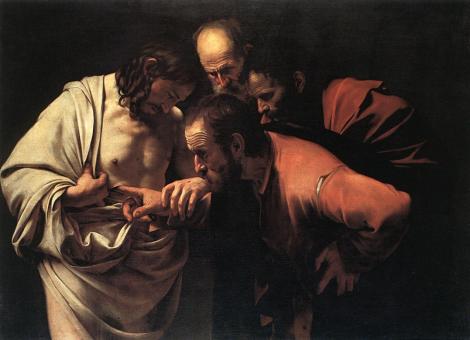A touch. A fingertip feeling pulsing muscles and skin – the same fingertip that had felt the temperature of a glass of milk, that had flowed through curtains and childrens’ hair – is the fingertip Caravaggio uses for the climax of the Christian epic: Thomas finally settles his doubts and touches Jesus’ crucifixion marks. When the women and the other ten apostles told Thomas Jesus had appeared to them after his death, he could not believe it. But this touch…
The apostles did not believe it either when they first heard from the women – but then they saw him, and the unexpected became true. Still, Thomas could not believe it. And who can judge him? Even if his closest companions attested that they had seen Jesus alive after his death, Thomas could still hear the nails being driven into his hands, smell the blood flowing from his wounds, see the dust floating across the light beams as they placed Jesus’ body in a tomb. He had seen a dead body, lifeless, cold, still. And only undeniable proof could change Thomas’ mind: “Unless I see the nail marks in his hands and put my finger where the nails were, and put my hand into his side, I will not believe.” [1]
For Thomas, the days between the news of the resurrection and his own encounter with Jesus must have been anguished. He wanted to believe, of course; he wanted to see his old friend back to life, to see death defeated before his eyes. But the texture of reality around him breathed a different spirit: cold, earthly, indifferent, often cruel. Thomas saw the world turning gray on that Friday afternoon, his friend crucified on a cross and his hope crucified within. The touch of Jesus’ cold body must have lingered on his fingers, the touch of incarnated goodness now reduced to a static corpse, violated and beaten.
But then Jesus appears to him, seemingly beyond logic, and Thomas’ finger is warmed by life and blood. Hard bone, pulsing flesh, the sound of heartbeat; a live breathing body, not the lifeless corpse he had touched before. Caravaggio amplifies the drama of this encounter with a technique called chiaroscuro, which he had learned from Leonardo da Vinci: the background is dark, and light is poured on Jesus’ body. To Thomas this scene is more concrete and physical than anything around them. In fact, this moment will illuminate his life from  now on: it will be the clarity which makes sense of this dark world, the understanding that will reshape his fears and hopes and loves and desires.
now on: it will be the clarity which makes sense of this dark world, the understanding that will reshape his fears and hopes and loves and desires.
Thomas’ reality is changed. The light of this moment, the warmth of this touch will stay on with him. His finger will carry this warmth as he touches faces or mud or spears, as he grabs a hard stone or as he touches his brides’ arm. He won’t even be able to eat the essential elements of the Mediterranean cuisine – bread, wine, water, oil – without remembering the resurrected Christ. Thomas’ senses are impregnated; his sight and smell and touch and taste and ears carry the ring of the resurrection. The texture of reality now breathes and pulses with life, even as he ventures later into the dark cold background.
René Breuel
[1] John 24:25

Pingback: Why is “seize the day” our universal motto? | Wondering Fair·
Pingback: Perché il nostro motto universale è “Cogli l’attimo”? | René Breuel·
Pingback: Artists’ spiritual insights | Wondering Fair·